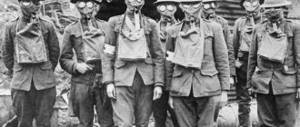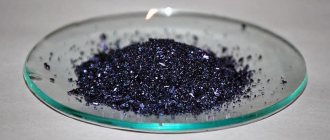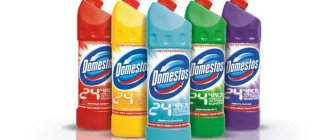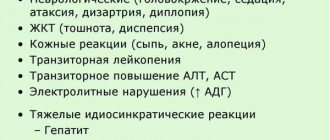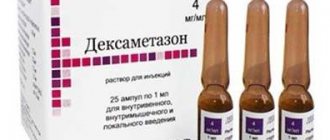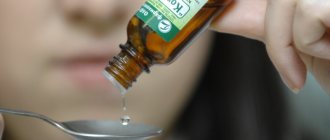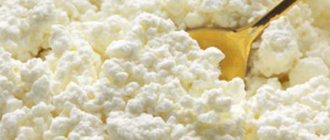Naphthalene is a chemical in the form of crystals that is obtained from coal tar . It is an aromatic hydrocarbon with a characteristic odor. The compound, in terms of its toxicity, belongs to hazard class 4 (low-hazard substances). Naphthalene poisoning is possible in two cases. The first is in case of non-compliance with safety regulations at work in the chemical industry. The second is at home, when naphthalene is used as an insecticide - a means to kill harmful insects.
Health effects
In acute poisoning, naphthalene causes headaches, nausea, vomiting, and irritation of the mucous membranes. Long-term exposure to mothballs can damage or destroy red blood cells (RBCs). Chronic exposure to naphthalene also leads to disruption of the liver and pancreas, causing the development of atrophic rhinitis and pharyngitis.
The International Agency for Research on Cancer (IARC) has classified naphthalene as a possible carcinogen, causing cancer in humans and animals.
In the human body, it is most often concentrated in adipose tissue, where it can accumulate until the adipose tissue begins to be burned and the poison enters the blood, after which the body is poisoned (bleeding, tumors, etc.).
First aid and treatment
In case of poisoning by poison vapors, it is necessary to immediately remove the victim to fresh air. The person is ensured complete rest and an emergency medical team is called. If the substance comes into contact with the skin, wash the affected area with copious amounts of water. The procedure is carried out over 15 minutes. If the compound gets into your eyes, rinse the substance under running water. When wearing lenses, it is recommended to remove them before cleaning.
If naphthalene is swallowed, it is strictly forbidden to use absorbent tablets and neutralizing solutions. It is not recommended to use the drugs within 24 hours after intoxication. Pharmacological agents can actively enter into a chemical reaction with naphthalene and intensify the pathological condition. The consequence may be irreversible.
The insecticide is stored in containers that are difficult for children to access. Wash your hands thoroughly after applying a chemical compound. If there is a strong odor in the room, it is recommended to ventilate the room by opening a window or door. To avoid poisoning at work, it is necessary to use protective glasses and gloves. Industrial buildings must be equipped with exhaust hood and high-quality ventilation.
Naphthalene is a flammable compound. Smoking is prohibited when working with the substance. During the hot season, the chemical activity of the element increases noticeably.
If mothballs are inadvertently ingested, a thorough examination is not required. A targeted diagnosis of the victim’s body will be appropriate for methemoglobinemia, hemolysis and G-6-PD deficiency. If large doses of vapors are inhaled at work, emergency medical attention will be required. Let's consider the main treatment options for this intoxication:
- Gastric lavage is necessary in acute forms of poisoning.
- The use of activated carbon is prescribed according to the scheme 1g/kg once a day.
- In case of severe anemia, blood transfusion is performed. Further development of a pathological condition that poses a threat to life is excluded. Normalization of a person's condition is carried out quickly, since red blood cells are resistant to hemolysis.
- With pronounced methemoglobinemia, methylene blue is administered. The dosage is selected at the rate of 1-2 mg/kg (0.15 ml/kg of 1% solution) IV.
Emergency care for a patient with naphthalene poisoning is based on a number of complex actions. First of all, life-threatening factors are eliminated. Concerns circulatory disorders and breathing problems. An effective tool is artificial ventilation. It is important to fight edema, quickly eliminate pain syndromes, acidosis and heart failure.
The combination of methylene blue (1%) and glucose solution (5-20%) allows you to reduce the level of MetHb concentration in the blood. As prescribed by a qualified physician, intravenous infusion is performed. Mix 100 ml of sodium thiosulfate solution (30%), 30 mg of prednisolone and 2 ml of pyridoxine. The use of other drugs is carried out under the strict supervision of a doctor.
In acute forms of naphthalene poisoning, an infusion of a glucose-naphthalene type mixture (possibly thermite) is injected. Plasma alkalization procedures follow. At the same time, tests are taken to determine the state of the circulatory and nervous systems.
Notes
- ↑ 12345
CRC Handbook of Chemistry and Physics/DR Lide (Ed.). — 90th edition. - CRC Press; Taylor and Francis, 2009. - 2828 p. — ISBN 1420090844. - ↑ 123
https://www.cdc.gov/niosh/npg/npgd0439.html - XuMuK.ru - NAPHTHALEN - Chemical encyclopedia
- Termites poison ants with mothballs
naphthalene: basic information about the pesticide
Description: An insecticide used as a moth repellent to protect clothing fur and as an animal repellent against vertebrate pest pests. It is also a direct component of some inert product additives.
Year of official registration: —
Release of pesticides onto the market (Directive 91/414/EEC), status:
| Status | No - not a ppp |
| Speaker/co-speaker dossier | Not determined |
| The enable date is about to expire | Not determined |
Approved (V) or known (#) in the following European countries:
| # | # | # | # | # | # | # | # | # | # | # | # | # | # | # | # | # | # | # | # | # | # | # | # | # | # | # |
Also registered in: USA
Basic information:
| Type of pesticide | Repellent, Constituent of another product | |||
| Other type | Included in some solvents | |||
| Chemical Structure Group | Aromatic hydrocarbons | |||
| Nature of action | Through a strong aroma | |||
| CAS registration number | 91-20-3 | |||
| Code CF (Enzyme Code) | 202-049-5 | |||
| International Cooperative Pesticide Review Council (CIPAC) code | 8222 | |||
| US Environmental Protection Agency (US EPA) Chemical Code | 055801 | |||
| Chemical formula | C10H8 | |||
| SMILES | c12ccccc1cccc2 | |||
| International Chemical Identifier (InChI) | InChI=1/C10H8/c1-2-6-10-8-4-3-7-9(10)5-1/h1-8H | |||
| Structural formula | ||||
| Molecular weight (g/mol) | 128.17 | |||
| IUPAC name | naphthalene | |||
| CAS name | naphthalene | |||
| Other information | — | |||
| Herbicide resistance according to HRAC | Not determined | |||
| Insecticide resistance according to IRAC | Not determined | |||
| Fungicide resistance according to FRAC | Not determined | |||
| Physical state | White Solid Transparent Rows | |||
Release:
| Index | Meaning | |||
| Pesticide Manufacturers | — | |||
| Commercial names of drugs containing a.v. |
| |||
| Associated with this substance: | — | |||
| Assessing the risk of a pesticide to the local environment (England) | Not determined | |||
| Preparative form and application features | — | |||
Paths of penetration of poison into the body and symptoms of poisoning
Naphthalene does not pose a serious threat to humans. Acute poisonings are extremely rare. The negative processes that occur in the body during intoxication are reversible.
Naphthalene penetrates into internal systems and environments through the respiratory tract, skin, and digestive tract
. Poisoning with the substance can be acute or chronic. Each person's sensitivity to mothballs is not the same. Therefore, the clinical picture manifests itself with different intensity.
Signs of acute intoxication
Inhalation of mothball vapor is less dangerous than ingestion
. The vapor concentration of the substance in the air does not reach high levels. Upon penetration through the mucous membranes of the respiratory tract, the substance is quickly absorbed into the systemic bloodstream and has a toxic effect on the nervous system.
Signs of acute poisoning due to the inhalation route of penetration of poison into the body:
- headaches in the temples, parietal region;
- dizziness;
- nausea associated with brain damage;
- single or repeated vomiting;
- increased sweating;
- chills, fever;
- dark urine due to toxic inflammation of the kidneys and impaired glomerular filtration.
When poisoned by naphthalene vapors, the mucous membrane of the eyes is not damaged. There are no signs of skin intoxication.
If a person swallows a solid substance, then symptoms of gastrointestinal damage develop:
Prevention measures
- You can prevent the spread of moths by sunbathing your items or drying them in direct sunlight.
- Freezing temperatures kill moths in any phase of their development. Therefore, with the onset of cold weather, it would be good to freeze fur coats, hats and especially carpets made from natural materials.
- Having discovered moths in a closet, the damaged items are immediately thrown away along with the larvae and eggs. The cabinet is treated with soapy water. Only then are the bags of naphthalene tablets stacked and things are distributed on the shelves. They must be clean and well dried.
- If household items or clothing are stored in bags, the packaging must be airtight. Inside the pile there is naphthalene.
Attention! The pungent smell of the drug can be removed by hanging things for 2-3 days in the sun or in a draft. If the clothes are leather, then solar radiation harms them. Therefore, it is better to place leather jackets, sheepskin coats, and raincoats outdoors, but in the shade.
Areas of application
What is naphthalene? This is a substance known for its high chemical activity. The substance is widely used in the metallurgical and textile industries. The beneficial qualities of naphthalene are also known and are used in folk medicine. The substance is also used in everyday life. In particular, naphthalene tablets are an effective insecticide.
ethnoscience
What is naphthalene and what healing properties does the substance have? The product has a positive therapeutic effect on the body for various types of infections and diseases of the respiratory organs. For these purposes, naphthalene crystals are placed in boiled water and inhalations are used. Similar treatment methods are often practiced in sanatoriums. Inhalations using naphthalene have an antibacterial effect on the mucous membranes of the lungs, oral cavity, and nasopharynx. The main goal of such events is to activate the separation of mucus from the bronchi.
Naphthalene is used to eliminate infectious lesions of the gastrointestinal tract. The antiseptic properties of the substance help restore normal functioning of the digestive system. The use of naphthalene also brings relief in the development of enterocolitis and diarrhea.
Gout has long been treated as a folk remedy based on naphthalene. To prepare it, about 25 grams of powdered crystals were mixed with milk. The composition was boiled and then left in a water bath for 10-15 minutes, stirring occasionally. The resulting medicine was placed in a cold place. The product was used to lubricate areas of the body in which inflammatory processes were observed.
In folk medicine, the substance is used to eliminate pathological manifestations on the skin. Naphthalene has a positive effect in the treatment of psoriasis and eczema. Crushed crystals have a disinfecting effect on non-healing wounds.
The chemical substance can be used if vision deteriorates. In the past, ophthalmologists and homeopaths recommended the use of naphthalene in cases of cataract development, as well as retinal tissue detachments.
What is the harm from lepidopteran insects?
Fur moth - causes great damage
The butterfly that lives in wardrobes is dangerous because of its offspring. Larvae in the form of caterpillars consume horny matter, technical felt, extracting it from woolen items, feathers, outerwear (lint of fur coats, sheepskin coats), carpets, felt boots. After eating keratin, holes remain on things, as well as excrement, which spoils the appearance. The carriage-feeding insect causes damage to thermal insulation, books, museum exhibits, etc. In fact, there are about 40 species of pests, “specializing” in different types of farming: furniture, food, etc.
